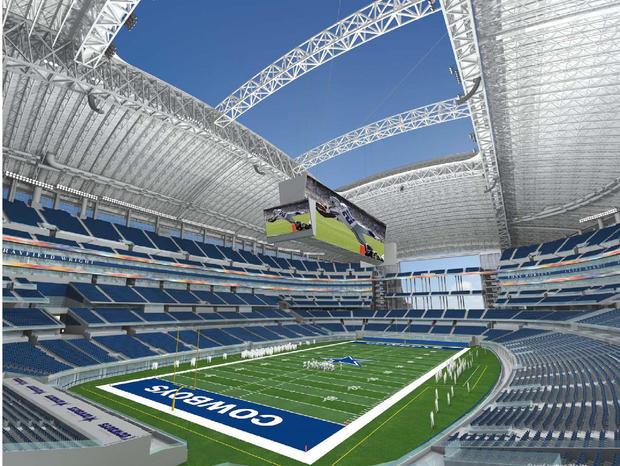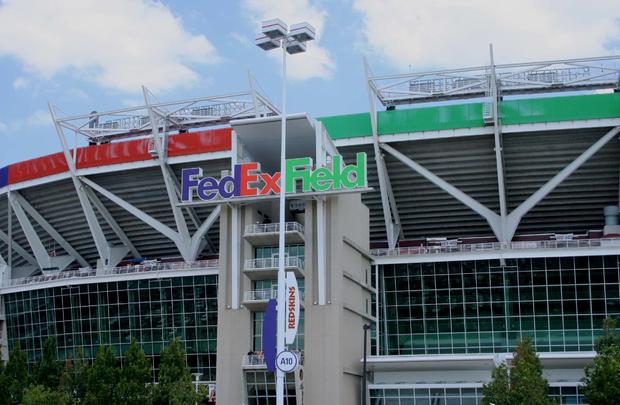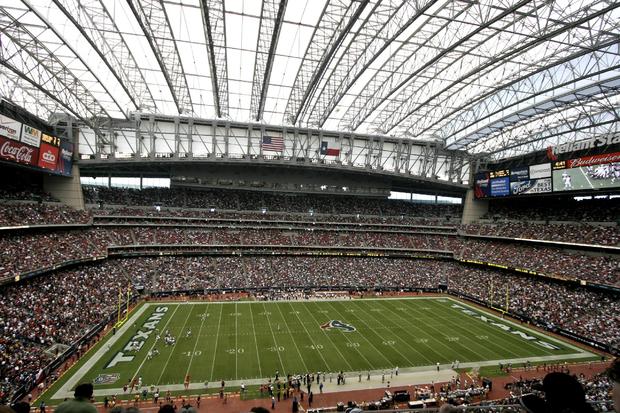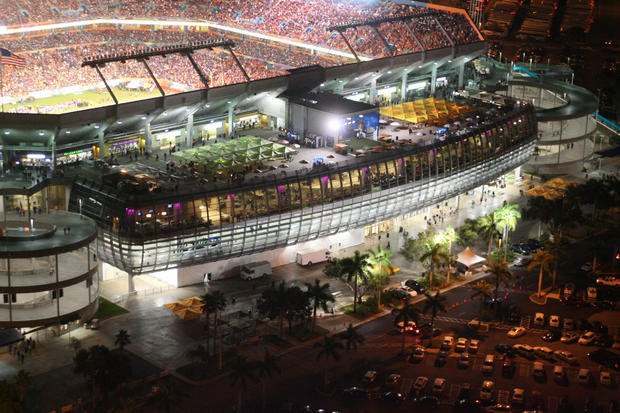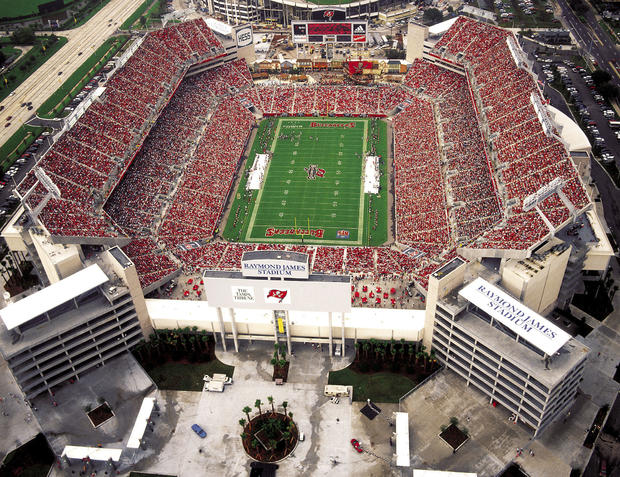The League's True MVPs: Top 10 Stadiums by Revenue
Cowboys Stadium
Year opened: 2009
Stadium revenue: $369 million*
Average ticket price: $90
Luxury suites: 200
Club seats: 15,000
Stadium capacity: 80,000
Before Cowboys fans can pay $340 per game for a club seat in the new stadium, they must fork over anywhere from $16,000 to $150,000 for a "personal seat license," which guarantees the right to buy season tickets for 30 years. By September 2008, the Cowboys' club seat PSLs had already generated at least $120 million.
The stadium is still under construction; revenue and capacity figures are projections, and a naming deal is pending.
(Image courtesy of the Dallas Cowboys/HKS Architecture)
The League's True MVPs: Top 10 Stadiums by Revenue
FedEx Field
Year opened: 1997
Stadium revenue: $327 million*
Average ticket price: $79*
Luxury suites: 243
Club seats: 15,044
Stadium capacity: 91,665*
The league's biggest stadium by capacity, FedEx Field boasts an unusually broad selection of first-class seats: club-level start at $2800 each for the season, field-level "dream seats" cost $4450, and the recliners in the climate-controlled loge level go for $4950.
(Photo courtesy of dbking, Creative Commons 2.0)
The League's True MVPs: Top 10 Stadiums by Revenue
Gillette Stadium
Year opened: 2002
Stadium revenue: $282 million*
Average ticket price: $100*
Luxury suites: 88
Club seats: 6,600
Stadium capacity: 68,756*
Game day can only generate so much revenue, so the Pats developed an additional way to profit from stadium land — Patriot Place, a 1.3 million-square-foot mall next to the field, where rent from anchor stores like Old Navy and Bass Pro Shops goes straight to the team's coffers. As the 2008 season opened, merchants had already committed to 90 percent of the retail space.
(Photo courtesy of the New England Patriots)
The League's True MVPs: Top 10 Stadiums by Revenue
Reliant Stadium
Year opened: 2002
Stadium revenue: $239 million*
Average ticket price: $61*
Luxury suites: 187
Club seats: 8,200
Stadium capacity: 71,116*
Reliant Energy, Texas's second-largest power provider, paid $300 million to place its name on the Texans' stadium until 2032 — the NFL's most lucrative stadium sponsorship deal to date.
(Photo courtesy of Ed Schipul, Creative Commons 2.0)
The League's True MVPs: Top 10 Stadiums by Revenue
Lincoln Financial Field
Year opened: 2003
Stadium revenue: $237 million*
Average ticket price: $72*
Luxury suites: 172
Club seats: 10,828
Stadium capacity: 67,594*
At "the Linc," the Eagles score serious cash from one of the most expensive premium seating options in the NFL — the Touchdown Club, which includes front-row seats, front-row parking, access to the luxury lounge, and gourmet champagne-and-crab-legs tailgate fare. A pair of season tickets costs $15,000.
(Photo courtesy of the Philadelphia Eagles)
The League's True MVPs: Top 10 Stadiums by Revenue
Dolphin Stadium
Year opened: 1987
Stadium revenue: $232 million*
Average ticket price: $66*
Luxury suites: 193
Club seats: 10,209
Stadium capacity: 75,540*
Dolphin Stadium became the league's first to include a luxuriously appointed "club level," a section where fans pay $1,000 to lease a seat for 10 years — in addition to buying annual season tickets for that seat. The seat licenses raised millions to offset construction costs, setting an NFL trend for club seating in new stadiums.
(Photo courtesy of Dolphin Stadium)
The League's True MVPs: Top 10 Stadiums by Revenue
Soldier Field
Year opened: 1924
Stadium revenue: $226 million*
Average ticket price: $85*
Luxury suites: 113
Club seats: 8,000
Stadium capacity: 61,500*
A whopping $632 million renovation of Soldier Field in 2003 shrank capacity by about 5,000 seats and resulted in the stadium's removal from the list of National Historic Landmarks. But fewer $60 general admission seats meant more room for luxury seats that bring in up to $350 each. The result? A big boost in revenue — the first season after the changes, the stadium earned $175 million in revenue, a $43 million gain from the year before.
(Photo courtesy of Soldier Field)
The League's True MVPs: Top 10 Stadiums by Revenue
M&T Bank Stadium
Year opened: 1998
Stadium revenue: $226 million*
Average ticket price: $77*
Luxury suites: 119
Club seats: 8,196
Stadium capacity: 70,107*
Desperate for a NFL franchise, the state of Maryland struck a generous stadium deal to lure the Cleveland Browns to Baltimore: In addition to owing no rent, the team's front office acquired the stadium's naming rights for just $10 million and subsequently resold them to M&T Bank for $75 million in 2003, pocketing the difference.
(Photo courtesy of the Baltimore Ravens)
The League's True MVPs: Top 10 Stadiums by Revenue
Invesco Field
Year opened: 2001
Stadium revenue: $226 million*
Average ticket price: $71*
Luxury suites: 124
Club seats: 8,800
Stadium capacity: 76,125*
The new Invesco Field has almost the same capacity as its predecessor — 76,125 seats, as opposed to the original Mile High Stadium's 76,123 — but now the Broncos bring in an average of $30 more per ticket, plus twice the old parking fees, and $3 million a year from the Invesco naming deal.
(Photo courtesy of the Denver Broncos)
The League's True MVPs: Top 10 Stadiums by Revenue
Raymond James Stadium
Year opened: 1998
Stadium revenue: $224 million*
Average ticket price: $72*
Luxury suites: 200
Club seats: 12,000
Stadium capacity: 65,908*
When real estate baron Malcolm Glazer bought the Bucs in 1995, he promised to fund half of a new stadium if the city paid the rest. But after Glazer made friends with the right politicians, voters passed a 1996 proposal to fund the full price of a new stadium entirely through taxes.
(Photo courtesy of the Tampa Sports Authority)
*From "The Business of Football." Forbes, September 10, 2008.
